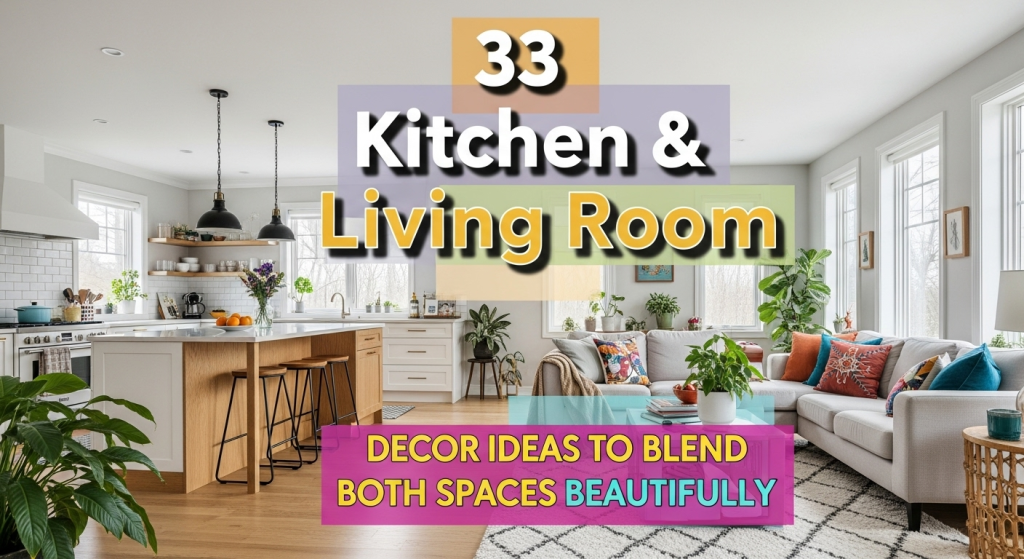Modern homes often feature open floor plans where the kitchen and living room flow into one another.
But just because they’re physically connected doesn’t mean they feel cohesive. Here’s how to make these two spaces harmonize beautifully with decor that unites them without sacrificing function or style.

Table of Contents
1. Use a Consistent Color Palette
Why it works: A unified color scheme visually ties both spaces together.
How to do it:
- Pick 2-3 dominant colors (e.g., white, navy, and wood tones).
- Repeat them across walls, upholstery, cabinets, and accessories.
What not to do: Avoid using drastically different wall colors or clashing tones between rooms.
2. Match Flooring
Why it works: Continuity underfoot makes the two rooms feel like one.
How to do it:
- Use the same wood, tile, or vinyl flooring throughout.
- If changing floors isn’t an option, use large area rugs in similar tones.
What not to do: Don’t mix tile in the kitchen with plush carpet in the living room—it disrupts the flow.
3. Incorporate a Unified Lighting Plan
Why it works: Lighting sets the mood and defines zones.
How to do it:
- Choose light fixtures from the same collection or in matching finishes.
- Use layered lighting: pendant lights over the kitchen island + floor lamps in the living area.
What not to do: Avoid mismatched lighting styles (e.g., industrial in kitchen and ornate in living).
4. Use an Area Rug to Define the Living Space
Why it works: Helps ground the furniture and subtly separate zones without walls.
How to do it:
- Choose a rug that echoes the color of kitchen cabinets or backsplash.
- Size it large enough so front legs of furniture rest on it.
What not to do: Don’t use busy patterns that clash with kitchen decor.
5. Create a Visual Bridge with Artwork
Why it works: Art can repeat colors and themes to connect both rooms.
How to do it:
- Hang complementary artwork in both areas.
- Use a gallery wall that stretches from the kitchen into the living zone.
What not to do: Avoid using completely different themes (e.g., coastal art in one, abstract in another).
6. Add a Statement Ceiling
Why it works: A uniform ceiling treatment unifies the whole space.
How to do it:
- Use wood beams, coffered designs, or tongue-and-groove panels.
- Paint the ceiling the same color throughout.
What not to do: Don’t use drop ceilings in one part and exposed beams in another—it disrupts flow.
7. Use Open Shelving That Flows Across Spaces
Why it works: Open shelves can display shared decorative items.
How to do it:
- Style with cookbooks, vases, plants, and art.
- Use matching brackets or wood tones.
What not to do: Don’t overstuff kitchen shelves while leaving the living room shelves bare.
8. Install a Double-Duty Island
Why it works: Serves as a visual and functional connector.
How to do it:
- Add bar stools facing the living room.
- Decorate the island with a fruit bowl or candle that matches the living room decor.
What not to do: Don’t treat the island like a food-only zone—it’s a social space too.
9. Create Cohesive Cabinetry + Built-ins
Why it works: Custom cabinetry in both spaces can look seamless.
How to do it:
- Match kitchen cabinetry to the living room media unit or bookshelves.
- Use same wood tones or paint finishes.
What not to do: Avoid stark contrast between sleek modern cabinets and rustic living room furniture.
10. Repeat Materials (Wood, Metal, Stone)
Why it works: Repetition of materials creates rhythm and unity.
How to do it:
- Use the same type of metal for light fixtures and cabinet hardware.
- Let marble from the kitchen echo in a living room coffee table.
What not to do: Don’t overuse too many materials; stick to 2-3.
11. Add a Focal Point that Connects Both Spaces
Why it works: A shared focal point draws the eye and unifies the area.
How to do it:
- A feature wall with wallpaper or wood paneling spanning both areas.
- A fireplace visible from both sides.
What not to do: Avoid having separate competing focal points.
12. Match Window Treatments
Why it works: Uniform curtains or shades link the spaces visually.
How to do it:
- Use same fabric, color, and length on all windows.
- Choose light-filtering or blackout options based on function.
What not to do: Don’t mix blinds in one room with curtains in another.
13. Blend Seating with Dining
Why it works: Creates a more relaxed, cohesive flow.
How to do it:
- Add a banquette or bench near the kitchen that echoes your sofa style.
- Upholster both in similar fabrics.
What not to do: Avoid clashing furniture silhouettes.
14. Use Repeating Shapes (Arches, Lines, Curves)
Why it works: Shared geometry subconsciously links spaces.
How to do it:
- Repeat circular forms in a mirror, coffee table, and bar stools.
- Echo archways in furniture design.
What not to do: Don’t mix too many shapes; it confuses the eye.
15. Add Indoor Plants Strategically
Why it works: Greenery softens edges and bridges spaces organically.
How to do it:
- Use similar pots and plant types throughout.
- Add trailing vines on top of cabinets or shelves.
What not to do: Don’t overclutter with too many mismatched pots.
16. Introduce a Cohesive Texture Story
Why it works: Similar textures bring warmth and consistency.
How to do it:
- Use woven baskets, linen fabrics, and natural wood in both spaces.
- Pair glossy kitchen surfaces with soft textiles like throw pillows and curtains.
What not to do: Avoid combining too many opposing textures like velvet and chrome without balance.
Also Read: 31 Blue Home Decor Ideas for a Royal Touch
17. Use Similar Decorative Accessories
Why it works: Repetition of accessories ties everything together.
How to do it:
- Use ceramic vases, metallic trays, or framed quotes in both rooms.
- Stick to 1–2 accessory styles to repeat.
What not to do: Avoid overly themed or mismatched decor items (e.g., farmhouse vs. ultra-modern).
18. Add a Feature Wall That Spans Both Rooms
Why it works: A bold accent wall visually anchors the entire space.
How to do it:
- Try vertical wood slats, bold paint, or a brick veneer wall.
- Extend it across both kitchen and living room walls.
What not to do: Don’t stop the feature wall at the edge of one zone—continue it across both.
19. Use Coordinated Furniture Styles
Why it works: Furniture with similar lines or finishes feels intentional.
How to do it:
- Pair mid-century modern bar stools with a similarly styled sofa.
- Use similar leg styles, woods, or colors.
What not to do: Don’t mix heavy traditional kitchen cabinets with ultra-minimalist living room pieces.
20. Create Symmetry with Decor Placement
Why it works: Balanced layouts create harmony and calm.
How to do it:
- Align pendant lights above the kitchen island with ceiling lights in the living room.
- Use symmetry in placing art or lamps.
What not to do: Avoid cluttered, unbalanced layouts that feel lopsided.
21. Install a Dual-Purpose Divider
Why it works: Adds subtle separation while maintaining openness.
How to do it:
- Use open shelving, a low console, or a slatted wood screen.
- Display decor visible from both sides.
What not to do: Don’t use solid or bulky walls that block the view.
22. Highlight a Shared View or Window
Why it works: Natural light is the ultimate unifier.
How to do it:
- Frame a large window with matching curtains.
- Arrange seating to enjoy the same outside view.
What not to do: Don’t obstruct shared windows with high-back furniture.
23. Use a Bar Cart or Sideboard as a Bridge
Why it works: These mobile pieces can live between both spaces.
How to do it:
- Style it with items like candles, glasses, or a plant that matches both areas.
- Choose a finish that reflects other furniture.
What not to do: Don’t overcrowd it with unrelated or clashing items.
24. Install Sliding or Glass Partitions
Why it works: Offers division without separation.
How to do it:
- Use clear or frosted sliding doors or glass panels.
- Frame in black metal for a modern look.
What not to do: Don’t use opaque walls or heavy curtains that isolate the spaces.
25. Add Coordinated Tableware & Display It
Why it works: Functional items can also be decorative.
How to do it:
- Use open shelves or glass cabinets to display dishes in the same palette as living room decor.
- Choose pretty storage jars and matching bowls.
What not to do: Don’t hide beautiful items in cupboards if they can act as visual connectors.
26. Install a Floating Media Console That Matches Kitchen Cabinets
Why it works: Custom cabinetry can flow from one room to another.
How to do it:
- Match cabinet color, handles, or wood grain.
- Mount the unit at the same height as lower kitchen cabinets.
What not to do: Avoid installing clunky or drastically different styles of built-ins.
27. Integrate Tech Thoughtfully
Why it works: Modern tech should blend, not distract.
How to do it:
- Mount smart speakers or screens in both rooms with hidden cords.
- Use matching wall mounts or cabinetry cutouts.
What not to do: Don’t let wires or bulky devices stand out visually.
28. Repeat Patterns (Stripes, Florals, Geometrics)
Why it works: Matching patterns visually connect zones.
How to do it:
- Use striped cushions in the living room and a striped runner in the kitchen.
- Choose a patterned tile that echoes throw pillows.
What not to do: Avoid mixing too many busy patterns—stick to 1–2 max.
29. Coordinate Seasonal Decor
Why it works: Matching seasonal touches make the space feel cohesive and festive.
How to do it:
- Use the same garlands, candles, or table runners in both rooms.
- Coordinate colors (e.g., gold + white in winter, terracotta in fall).
What not to do: Don’t decorate one space heavily and leave the other bare.
30. Use Layered Lighting Across Both Spaces
Why it works: Multiple light sources add coziness and cohesion.
How to do it:
- Pair ambient lighting (ceiling lights), task lighting (under-cabinet, reading lamps), and accent lighting (LED strips, sconces).
- Use dimmers for mood control.
What not to do: Avoid relying on just overhead lighting—it flattens the space.
31. Echo Kitchen Backsplash Colors in Living Room Textiles
Why it works: It creates an unexpected but pleasing harmony.
How to do it:
- If your backsplash is blue, include blue pillows, vases, or rugs.
- Repeat the color in subtle ways.
What not to do: Don’t ignore your kitchen finishes—they’re part of your palette.
32. Make Use of Architectural Details
Why it works: Arches, columns, or trim work can naturally unify a room.
How to do it:
- Paint molding or baseboards the same throughout.
- Highlight an arch with lighting or color.
What not to do: Don’t let one room look overly ornate and the other too plain.
33. Anchor the Whole Space with a Cohesive Style Theme
Why it works: A clear style makes the open-plan feel curated, not chaotic.
How to do it:
- Choose a style: Scandinavian, industrial, boho-modern, coastal, etc.
- Select furniture and accessories that fit the theme across both rooms.
What not to do: Don’t mix styles that don’t blend—like rustic kitchen and glam living room.
Final Tip: Let Function Meet Flow
While decorating is about aesthetics, keep function in mind. Create space to move, entertain, and live comfortably in both zones.
Cohesion isn’t about making everything match—it’s about making everything belong.









